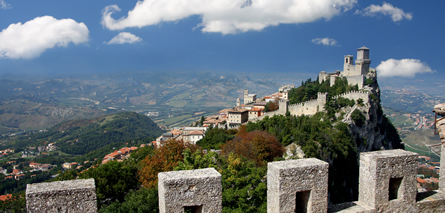
San Marino is situated on the top of the 738-metre-high
Mount Titano. The name of the mountain hides a paradox: in Greek Myhtology, Titans were giants. San Marino is the
smallest Republic in the world and it is very pride of it, as well as of the fact it is the most ancient one.
The history of San Marino dates back to 1,500 years ago: in the
fourth century, the
Dalmatian stonecutter Marino, who fled from Diocletian's prosecution together with other Christians, settled on the top of this impressive mountain.
Some centuries later, during the fights for independence, in 1263 San Marino was proclaimed a
Free Commune. Over the subsequent two centuries, it enlarged its territory, which in 1462 reached the current extension of
60,57 square kilometres.
It struggled for
independence and resisted the attack of bishops, popes and local lords.
Its “prize” was the recognition of autonomy, which occured in three different historical periods: in 1740 by Pope Clemente XII, in 1815 by the Congress of Wien and in 1862 by the new Italian state.
The history of San Marino is a
Medieval history. Notwithstanding progress and developments, the medieval atmosphere still permeates this lively village made up of narrow pedestrian streets, stone houses and palaces and small workshops.
On the top of Mount Titano are
three fortresses, the symbol of the medieval military tradition, which overlook the underlying landscape and are surrounded by impressive embattlements.
Mount Titano gazes across the countryside from on high. South-east are the
sweet rolling hills from Romagna and the Montefeltro, charming panoramic routes and an alluring landscape.
East are some plains and the wide expanse of the
Adriatic Sea. Impressive fortresses overlook the inestimable heritage San Marino cherishes from the top of a privileged position which made it a charming oasis set apart from the rest of the world.
Fortresses here bear witness to the ancient Medieval Age, and so do other monuments, such as
Palazzo del Governo, which dominates Piazza della Libertà, the most important gathering place in San Marino. It is a stone building featuring Gothic arches and wide windows and dominated by the embattlements of the tower, the clock tower and the bell of the arengo. Although looking like a fourteenth/fifteenth-century building, it was realized by Roman architect Francesco Azzurri and inaugurated on September 30,
1894 with a speech dealing with "endless freedom" by Giosué Carducci.
The combination of the old and the new is one of the most peculiar characteristics San Marino boasts, together with the
stylistic loyalty of a State which constantly renovates itself, thus attracting three millions people every year.
A trip to San Marino gives people the possibility to enjoy the past fascination of its
ancient village and to discover a charming Republic which aims at promoting its most important historic attractions.
Institutional ceremonies here are real shows featuring
period costumes and rituals, flags, coats of arm and historic recollections. Not to be missed are
Crossbowmen: 600 years ago they were soldiers and now stage folk performances together with a group of flagwavers.
Besides folk traditions, San Marino is always
crowded with tourists flocking to its small squares, monuments and churches in order to enjoy breathtaking views over the underlying landscape.
Here are traditional tourists meccas: the fourteenth-century
church of St. Francis; the nearby art gallery gathering paintings by Guercino and Tiziano; the
State Museum, which cherishes precious paintings and outstanding memorabilia dating back to the history of the Republic, and many more.
This section describes another aspect of San Marino, the commercial one. The Republic is a
big bazaar which offers guests
every kind of souvenir, such as model weapons, medieval coats of arm, crossbows and swords and plenty of toys made in Taiwan”.
Not to be missed are the local sculptures which reproduce the fortresses, a peculiarity of San Marino like the Venetian gondolas and the Leaning Tower of Pisa.
The three fortresses, the national symbol of the Republic, are also reproduced on local
stamps: the art of collecting here is very widespread. Stalls sell postcards provided with stamps and Post Offices sometimes burn some specimen to increase the value of the outstanding ones.
Other famous local staples are
spirits. Local industries produce hundreds of different types of them and the shelves of local shops are crowded with bottles. Local producers realize both spirits and packages using utmost creativity and imagination.
There are violin-shaped bottles, bottles covered with rind and even
sculptured bottles reproducing fortresses, fountains and wells, Paolo and Francesca, period cars and so on.
Not to be missed are curious items: mechanical parrots, bomb-shaped lighters, small plastic wcs,
shields and swords and many more.
 San Marino is situated on the top of the 738-metre-high Mount Titano. The name of the mountain hides a paradox: in Greek Myhtology, Titans were giants. San Marino is the smallest Republic in the world and it is very pride of it, as well as of the fact it is the most ancient one.
San Marino is situated on the top of the 738-metre-high Mount Titano. The name of the mountain hides a paradox: in Greek Myhtology, Titans were giants. San Marino is the smallest Republic in the world and it is very pride of it, as well as of the fact it is the most ancient one.